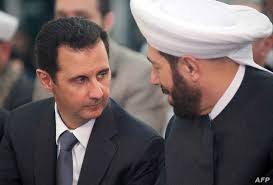Dubbed as the "Barrel Bombs Mufti," who is Ahmad Badr al-Din Hassoun?

Ahmad Badr al-Din Hassoun, the former Grand Mufti of the Syrian Arab Republic during the rule of President Bashar al-Assad, is one of the most controversial religious figures in modern Syrian history. He became known for his unwavering support for the Syrian regime, provocative statements attacking opponents and refugees, and incitement to violence against civilians. He was even dubbed by opponents of the former Syrian regime as the "Mufti of Barrels" for justifying the bombing of residential neighborhoods with explosive barrels during the Syrian civil war.
Early Life and Academic Path
Ahmad Badr al-Din Mohammad Hassoun was born on April 25, 1949, in the city of Aleppo, the economic capital of Syria, and was raised under his father, Sheikh Mohammad Adib Hassoun, a well-known religious scholar. He received his early education in Aleppo, obtained his high school diploma in 1967, then traveled to Egypt to attend Al-Azhar University, where he earned a bachelor's degree in Arabic literature, followed by a Ph.D. in Shafi'i jurisprudence. He also received an honorary doctorate from Sunan Kalijaga Islamic University in Indonesia in recognition of his speech at the European Parliament in 2008 on intercultural dialogue.
Religious and Political Career
Hassoun began his religious career in 1967 as a preacher and imam in mosques in Aleppo, such as the Tawabin Mosque and the Great Umayyad Mosque. In the early 1990s, he chaired the Association for Health and Social Elevation and was elected as a member of the Syrian People's Council in 1990, a position he held until 1998.
He became the Mufti of Aleppo in 2002, then became the Grand Mufti of Syria in July 2005, succeeding Sheikh Ahmad Kuftaro after his death. During his tenure, he participated in international religious institutions, such as the World Assembly for Proximity of Islamic Schools of Thought in Iran, and delivered speeches at global platforms, including the European Parliament, where he received the Peace Award from the Italian Duchy Foundation in 2014.
Role in the Syrian Revolution: "Mufti of Barrels"
With the outbreak of the Syrian revolution in 2011, Hassoun fully sided with the Assad regime, describing the protests as a "terrorist conspiracy supported from abroad," adopting the regime's official narrative. He issued controversial fatwas justifying the bombing of civilians, calling for the "extermination" of opponents in Aleppo neighborhoods, and describing barrel bombing operations as "liberation." In a televised speech in 2011, Hassoun threatened to train "suicide bombers" in Europe and America if Syria were attacked. He also claimed that the map of Syria is mentioned in Surah At-Tin, and referred to refugees as "the lowest of the low" for leaving the country.
Accusations of Complicity in War Crimes
A report by Amnesty International in 2017 revealed that Hassoun was one of those responsible for signing orders to execute around 13,000 detainees in Sednaya prison, where death sentences were approved by the Grand Mufti and the Minister of Defense on behalf of Assad.
Recent Arrest and Unknown Fate
On March 26, 2025, Syrian security forces arrested Hassoun at Damascus International Airport while attempting to travel to Jordan for surgery. The arrest came after months of popular protests against him in Aleppo, where protesters demanded his trial. The official reasons for the arrest were not announced, but it is believed to be part of the regime's campaign to settle